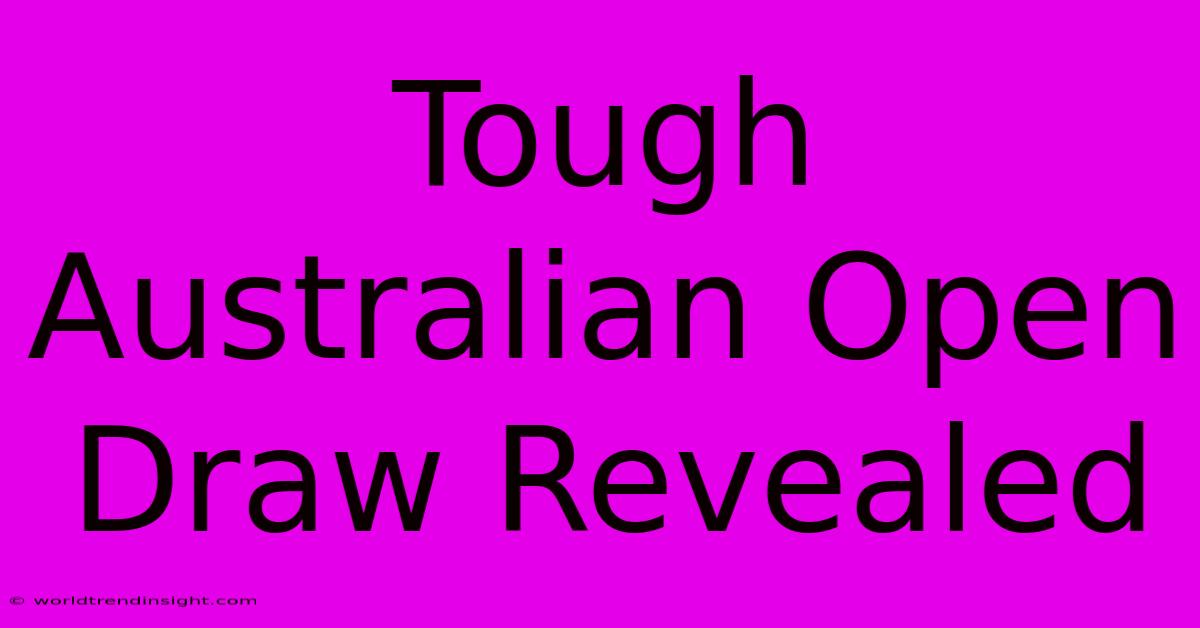Tough Australian Open Draw Revealed

Discover more detailed and exciting information on our website. Click the link below to start your adventure: Visit Best Website Tough Australian Open Draw Revealed. Don't miss out!
Table of Contents
Tough Australian Open Draw Revealed: My Gut-Wrenching Experience and Tips for Predicting Upsets
Ugh, the Australian Open draw. Just the words themselves make my palms sweat a little. I remember one year, I'd spent weeks meticulously analyzing the players, their forms, head-to-head records... the whole shebang. I even built this super complicated spreadsheet – seriously, Excel wizard level stuff – predicting potential upsets and semi-finalists. I thought I had it all figured out. I was feeling pretty smug, let me tell you. Then BAM! My top pick, a rising star I'd predicted to go all the way, got knocked out in the first round by some qualifier nobody had ever heard of. Talk about a gut punch! It taught me a valuable lesson, though: predicting tennis is hard!
Understanding the Seeds and Beyond: More Than Just Numbers
The Australian Open draw, like any Grand Slam draw, is deceptively simple on the surface. You've got your seeded players, ranked 1 to 32 (or so). They're supposed to be the best, right? Ideally, they avoid each other until the later rounds. But, you know, ideally. The reality is way more chaotic. This year's draw threw up some seriously interesting matchups early on. It's crazy how a few early-round upsets can completely flip the script on the entire tournament.
The seedings are based on the ATP or WTA rankings, which are influenced by many factors. Recent performance, of course, but also things like the number of matches played on different surfaces and even the prestige of the tournaments they’ve won. It’s not just about the ranking number. You really gotta dig deeper. I’ve learned this the hard way.
Key Factors Beyond the Rankings: Form is Everything!
Forget about past glories for a sec. Recent form is way more important, especially considering injuries. A player might be highly ranked, but if they've been struggling with injuries or haven't played many matches leading up to the Aussie Open, their ranking might be misleading. You really need to look at their recent tournament results. Even better, search for details on recent training. Did they have a good prep? Were there any injury issues or setbacks? It's amazing the info you can find online if you're willing to dig!
Looking back at my spreadsheet fiasco, I realized I’d focused too much on the rankings and head-to-head stats. I hadn’t paid enough attention to the current form of the players. A few extra minutes spent on checking recent matches and interviews could've saved me a heap of disappointment – and maybe a few bucks on my predictions!
Surface Matters: A Big Deal in Melbourne
Another thing I've learned the hard way? The playing surface matters a lot. The Australian Open is played on hard courts, which suits some players more than others. Some players excel on hard courts, while others might prefer clay or grass. Consider this – a player might be ranked higher, but their game might not be as well suited to hard courts. A lower-ranked player who is comfortable on hard courts could easily upset them.
This year's draw looks particularly interesting. I'm seeing some early-round matches that could create some huge upsets. Analyzing things like this is key to building more accurate predictions. So, if you're making your own predictions, don't just look at the seedings. Seriously, do your research. Check out the players' recent forms, head-to-head records (if they exist), and think about how well their playing style matches up with the hard courts. It's a bit of work, but it makes the tournament a whole lot more exciting, and your predictions will be a heck of a lot more accurate! Trust me on this one!

Thank you for visiting our website wich cover about Tough Australian Open Draw Revealed. We hope the information provided has been useful to you. Feel free to contact us if you have any questions or need further assistance. See you next time and dont miss to bookmark.
Featured Posts
-
Whites Police Career Questioned
Nov 27, 2024
-
Huge Chicken Hotel Record Breaker
Nov 27, 2024
-
Extra Bank Holiday 2025 Uk
Nov 27, 2024
-
Champions League Matchday 5 Possible Lineups
Nov 27, 2024
-
Gunners Rout Sporting 5 1
Nov 27, 2024
